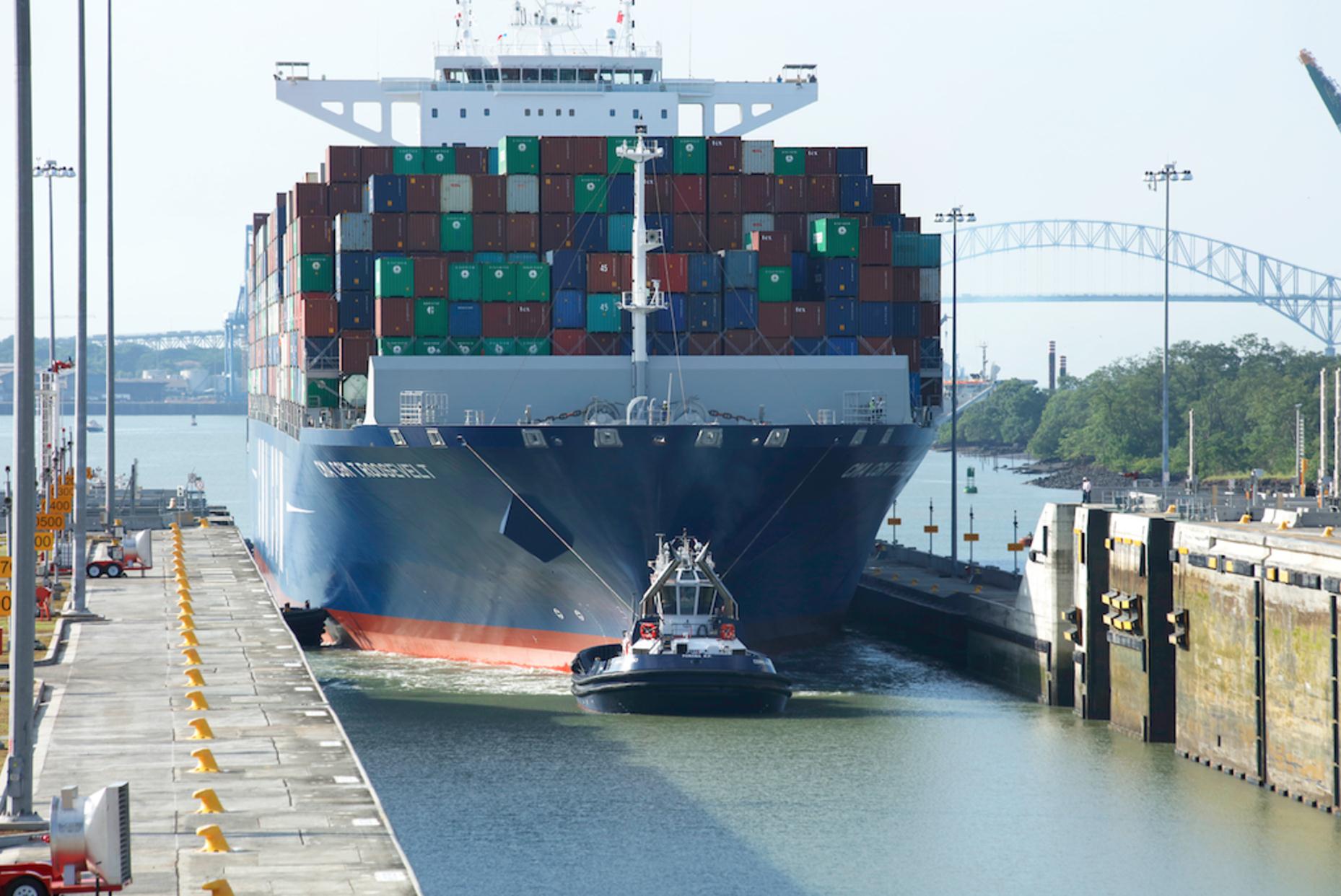Amid celebrations of a successful first year of operation following the Panama Canal’s ambitious expansion project, the canal authority demonstrated again the need for the expanded canal project on August 22, when the CMA CGM Theodore Roosevelt transited the locks on its way from Asia to the US East Coast. The Neo-Panamax container ship – with a total TEU allowance (TTA) of 14,855 and length of 365.9 metres – is the largest-capacity vessel to ever transit the expanded locks.
“Today’s transit not only represents the growing success and adoption of the expanded canal, but also its impact on reshaping world trade,” said Panama Canal administrator Jorge L. Quijano.
The Theodore Roosevelt is deployed on the new Ocean Alliance’s weekly South Atlantic Express (SAX) service. The SAX service is composed of 11 vessels ranging in size from 11,000 to 14,000 TEUs, including vessels which also transited the expanded canal earlier in May, becoming the largest-capacity ships to do so at the time.
The canal authority says that more than 1,500 Neo-Panamax vessels transited the expanded canal in its first year, following the COSCO Shipping Panama, which set sail June 11 from the Greek Port of Piraeus carrying 9,472 TEUs and measuring 299.98 metres in length. Originally named Andronikos, the vessel was renamed to honour and pay respect to the country of Panama and the canal, and became the first ship to transit the expanded canal on June 26, 2016.
Container ships represent approximately 51.3 percent of traffic through the expanded canal, followed by LPG and liquefied natural gas (LNG) carriers, which represent approximately 31.5 and 9.1 percent, respectively. Other segments such as bulk carriers, tankers, car carriers and passenger vessels have also transited the Neo-Panamax locks, authority officials say.

Over the past 12 months, the expanded canal’s performance has exceeded what was originally forecast, as global trade routes have been redrawn. On average, 5.9 vessels transit the expanded canal per day, surpassing original forecasts of two to three daily transits for the first year of operation. Total Panama Canal tonnage has increased by 22.2 percent, when comparing the 2016 and 2017 fiscal year.
Additionally, officials note, 15 out of the 29 liner services that use the Panama Canal now employ Neo-Panamax vessels to take advantage of the economies of scale offered by the expanded canal. The majority of these liner services connect ports in Asia and the US East Coast.
“These transits are a testament to the global maritime industry’s confidence in the expanded canal,” said Quijano. “The countless accomplishments set over the past year have surpassed even our own expectations for the project. We would like to thank everyone involved, from our customers to our highly skilled employees, for their role in making this year such a great success.”
The Theodore Roosevelt began its voyage in Shanghai, and was scheduled to call at Norfolk, Savannah and Charleston on the US East Coast, as well the Port of New York and New Jersey, which recently completed a four-year, US$1.6 billion project to raise the Bayonne Bridge to 215 ft. The move will allow the nation’s third-largest port to accept ships larger than 9,500 TEUs to reach three of its four main terminals.
Canal officials noted that passage of the Theodore Roosevelt highlights the canal’s ability to reduce CO2 emissions compared to alternative routes. “By traveling through Panama, the vessel saved 29,561 tons of CO2 in bypassing the Cape of Good Hope,” the authority said in a statement.
Looking forward to the 2018 fiscal year, which begins on October 1, the Panama Canal Authority is projected to accommodate approximately 13,000 vessels, including 2,335 Neo-Panamax vessels for a record tonnage of 429.4 million Panama Canal tons (PC/UMS).
The canal authority also has a number of infrastructure projects planned to provide greater connectivity and transhipment opportunities to the region, including plans to concession a RoRo terminal to serve as a centre for the redistribution of vehicles, machinery and heavy equipment; a 1,200-hectare logistics park to strengthen the logistics services in the region; and an LNG terminal on the Atlantic side of the waterway to provide LNG bunkering and redistribution capabilities.
“[The] milestone provides us with an opportunity to reflect on the canal’s strong performance to-date and the industry’s wide-spread adoption of the waterway,” said Quijano. “Looking forward, the next decade will serve as a significant next chapter in the Panama Canal’s story as we continue to advance various infrastructure projects within the region to further position Panama as the logistics hub of the Americas.”
By Gregory Glass
Asia Cargo News | Hong Kong




